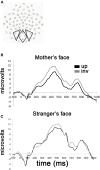Personal familiarity influences the processing of upright and inverted faces in infants
- PMID: 20204154
- PMCID: PMC2831707
- DOI: 10.3389/neuro.09.001.2010
Personal familiarity influences the processing of upright and inverted faces in infants
Abstract
Infant face processing becomes more selective during the first year of life as a function of varying experience with distinct face categories defined by species, race, and age. Given that any individual face belongs to many such categories (e.g. A young Caucasian man's face) we asked how the neural selectivity for one aspect of facial appearance was affected by category membership along another dimension of variability. 6-month-old infants were shown upright and inverted pictures of either their own mother or a stranger while event-related potentials (ERPs) were recorded. We found that the amplitude of the P400 (a face-sensitive ERP component) was only sensitive to the orientation of the mother's face, suggesting that "tuning" of the neural response to faces is realized jointly across multiple dimensions of face appearance.
Keywords: ERPs; face recognition; familiarity; perceptual learning.
Figures



References
-
- de Haan M., Johnson M. H., Maurer D., Perrett D. (2001). Recognition of individual faces and average face prototypes by 1- and 3-month-old infants. Cogn. Dev. 16, 659–67810.1016/S0885-2014(01)00051-X - DOI
Grants and funding
LinkOut - more resources
Full Text Sources

